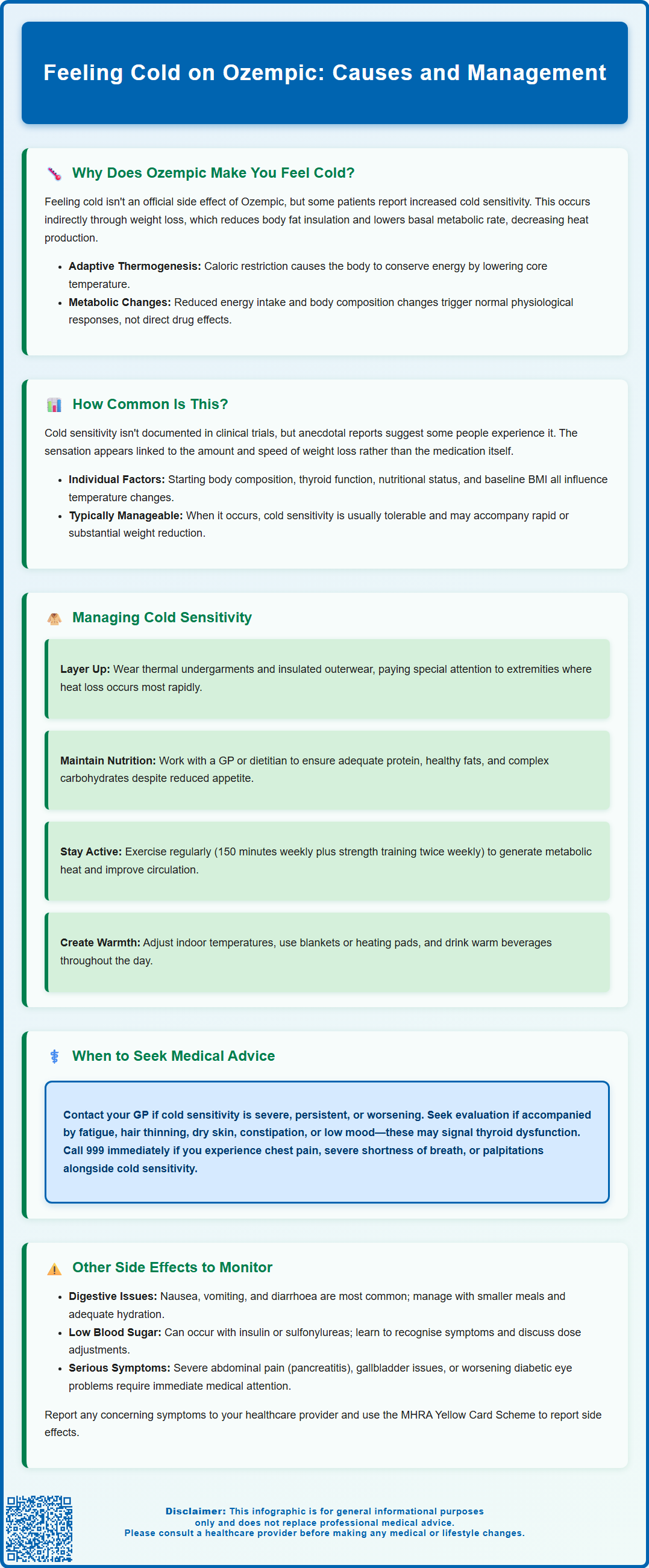Mounjaro®
Dual-agonist support that helps curb appetite, hunger, and cravings to drive substantial, sustained weight loss.
- ~22.5% average body weight loss
- Significant weight reduction
- Improves blood sugar levels
- Clinically proven weight loss

Feeling cold whilst taking Ozempic (semaglutide) is an experience reported by some patients, though it is not listed as an official adverse effect in UK regulatory documentation. This sensation typically relates to metabolic changes and weight loss rather than a direct drug effect. As Ozempic reduces appetite and promotes weight reduction, the body loses insulating adipose tissue and basal metabolic rate may decline, potentially leading to increased cold sensitivity. Understanding why this occurs, how common it is, and when to seek medical advice can help patients manage this symptom effectively whilst continuing their diabetes treatment safely.
Summary: Feeling cold on Ozempic is likely an indirect consequence of weight loss and reduced metabolic rate rather than a direct drug effect, though it is not documented as an official adverse reaction.
The most plausible explanation may relate to metabolic changes associated with weight loss. Ozempic works by enhancing insulin secretion, suppressing glucagon release, and slowing gastric emptying, which collectively reduce appetite and caloric intake. As patients lose weight—particularly adipose tissue—the body's natural insulation decreases, and basal metabolic rate may decline. This reduction in metabolic heat production could potentially manifest as feeling colder than usual, especially in cooler environments.
Additionally, caloric restriction itself may contribute to cold sensitivity. When energy intake is substantially reduced, the body may conserve energy by slightly lowering core temperature and reducing peripheral blood flow. This adaptive thermogenesis is a normal physiological response but can be uncomfortable for some individuals.
It is important to note that there is no established pharmacological link in clinical data between semaglutide's mechanism of action and altered thermoregulation. The sensation of feeling cold appears to be an indirect consequence of the metabolic and body composition changes induced by the medication, rather than a direct drug effect on temperature regulation centres in the hypothalamus.

Feeling cold whilst taking Ozempic is not documented as an adverse reaction in the MHRA/EMC SmPC, clinical trial data or regulatory documentation. The pivotal SUSTAIN trials, which evaluated semaglutide for type 2 diabetes, and the STEP trials for weight management did not identify cold intolerance as a statistically significant adverse event. However, anecdotal reports from patients and online communities suggest that some individuals do experience this symptom, particularly those achieving substantial weight loss.
The prevalence of cold sensitivity may be associated with the degree and rate of weight reduction, though this has not been formally studied. Patients losing significant amounts of weight over relatively short periods might potentially notice changes in temperature perception. In clinical practice, this symptom appears in discussions among individuals using semaglutide, but the actual frequency is unknown.
Individual variation likely plays a considerable role. Factors such as baseline body composition, pre-existing thyroid function, nutritional status, and environmental temperature all influence whether a patient experiences cold sensitivity. Those with lower starting body mass index (BMI) or those who lose weight rapidly may notice temperature changes more acutely.
Based on patient reports, feeling cold, when it occurs, appears to be generally manageable for most patients. However, if cold intolerance is severe, persistent, or accompanied by other concerning symptoms, further clinical evaluation is warranted to exclude alternative causes.
If you experience increased cold sensitivity whilst taking Ozempic, several practical strategies can help manage this symptom effectively without compromising your treatment.
Dress appropriately: Layering clothing is one of the simplest and most effective approaches. Thermal undergarments, fleeces, and insulated outerwear can help maintain body warmth, particularly during colder months. Pay attention to extremities—wearing warm socks, gloves, and hats can significantly improve comfort, as heat loss occurs most rapidly from the head, hands, and feet.
Maintain adequate nutrition: Whilst Ozempic reduces appetite, it remains important to consume sufficient calories and nutrients to support metabolic function. Work with your GP or a registered dietitian to ensure your eating plan provides adequate protein, healthy fats, and complex carbohydrates. Severe caloric restriction can exacerbate cold sensitivity and may compromise nutritional status.
Stay physically active: Regular exercise generates metabolic heat and can improve circulation, helping to maintain core body temperature. The NHS recommends at least 150 minutes of moderate-intensity activity per week for adults, plus strength training activities on at least 2 days per week. Activities such as brisk walking, swimming, or cycling can be particularly beneficial.
Optimise your environment: Adjust your home and workplace temperature to a comfortable level. Use blankets, hot water bottles, or heating pads when resting. Warm beverages throughout the day can also provide temporary relief and contribute to overall fluid intake.
Monitor your progress: Keep a symptom diary noting when cold sensitivity occurs and its severity. This information can be valuable when discussing your treatment with your healthcare provider and may help identify patterns or triggers. If symptoms persist, discuss with your GP who may consider testing for conditions like hypothyroidism or anaemia.
Whilst mild cold sensitivity associated with weight loss is generally not concerning, certain circumstances warrant prompt medical evaluation. You should contact your GP if you experience any of the following:
Severe or worsening cold intolerance: If you feel persistently cold despite appropriate clothing and environmental adjustments, or if the symptom progressively worsens, this may indicate an underlying issue requiring investigation.
Accompanying symptoms: Cold intolerance accompanied by fatigue, unexplained weight changes (beyond expected weight loss), hair thinning, dry skin, constipation, or low mood may suggest thyroid dysfunction. Hypothyroidism can develop independently of Ozempic use and requires specific treatment with levothyroxine. Your GP can arrange thyroid function tests (TSH, free T4), full blood count, ferritin and B12 levels to assess potential causes.
Signs of inadequate nutrition: If cold sensitivity occurs alongside dizziness, weakness, difficulty concentrating, or signs of malnutrition, your caloric intake may be insufficient. This is particularly important if you are experiencing severe nausea or vomiting—common gastrointestinal adverse effects of Ozempic that may compromise nutritional status.
Cardiovascular symptoms: Call 999 or go to A&E if cold sensitivity is accompanied by chest pain, severe shortness of breath, palpitations, or swelling of the legs. Whilst rare, these could indicate cardiovascular complications requiring immediate assessment. For urgent concerns when your GP is unavailable, contact NHS 111.
Peripheral circulation concerns: If you notice colour changes in your fingers or toes (pallor, blueness, or redness), numbness, or pain in extremities, consult your GP. These symptoms may indicate peripheral vascular issues, particularly relevant for patients with diabetes who have increased cardiovascular risk.
Your healthcare provider can perform appropriate investigations, review your medication regimen, and determine whether any adjustments to your Ozempic treatment or additional interventions are necessary.
Understanding the broader adverse effect profile of Ozempic helps patients recognise expected reactions and identify those requiring medical attention. According to the MHRA/EMC SmPC, the most commonly reported side effects are gastrointestinal in nature.
Nausea and vomiting are very common adverse reactions, particularly during dose escalation. These symptoms typically improve over time as the body adjusts to the medication. Eating smaller meals and avoiding fatty or spicy foods may help minimise discomfort. If nausea is severe or persistent, your GP may recommend anti-emetic medication or slower dose titration.
Diarrhoea and constipation are also common. Maintaining adequate hydration, consuming sufficient dietary fibre, and regular physical activity can help manage these symptoms. Persistent or severe gastrointestinal symptoms should be reported to your healthcare provider, as they may lead to dehydration and affect kidney function.
Hypoglycaemia (low blood glucose) can occur, particularly when Ozempic is used in combination with insulin or sulfonylureas. Symptoms include trembling, sweating, confusion, and palpitations. Patients should be educated on recognising and managing hypoglycaemia, and dose adjustments of concomitant diabetes medications may be necessary.
Injection site reactions—such as redness, itching, or swelling—can occur. These are usually mild and resolve spontaneously. Rotating injection sites can help prevent these reactions.
Less common but important adverse effects include pancreatitis (severe abdominal pain radiating to the back, nausea, vomiting), gallbladder disease, and diabetic retinopathy complications in patients with pre-existing eye disease. The SmPC also notes that rodent studies showed C-cell thyroid tumours, though the human relevance is unknown. Seek medical advice if you develop a neck mass, difficulty swallowing, persistent hoarseness, or breathing difficulties.
Patients should report any new, persistent, or concerning symptoms to their GP or diabetes specialist nurse. Regular monitoring as recommended by NICE guidelines—including HbA1c, renal function, and weight—helps ensure safe and effective treatment with Ozempic.
If you suspect you're experiencing side effects from Ozempic, report them to the MHRA Yellow Card Scheme (yellowcard.mhra.gov.uk or via the Yellow Card app).
Feeling cold is not documented as an official adverse effect in UK regulatory documentation or clinical trials, though some patients report increased cold sensitivity, particularly those experiencing substantial weight loss.
Cold sensitivity likely results from metabolic changes associated with weight loss, including reduced adipose tissue insulation, decreased basal metabolic rate, and adaptive thermogenesis from caloric restriction.
Contact your GP if cold intolerance is severe or worsening, or if accompanied by fatigue, hair thinning, dry skin, constipation, or low mood, as these may indicate thyroid dysfunction requiring investigation.
The health-related content published on this site is based on credible scientific sources and is periodically reviewed to ensure accuracy and relevance. Although we aim to reflect the most current medical knowledge, the material is meant for general education and awareness only.
The information on this site is not a substitute for professional medical advice. For any health concerns, please speak with a qualified medical professional. By using this information, you acknowledge responsibility for any decisions made and understand we are not liable for any consequences that may result.
Lorem ipsum dolor sit amet, consectetur adipiscing elit, sed do eiusmod tempor incididunt ut labore et dolore magna aliqua. Ut enim ad minim veniam, quis nostrud exercitation ullamco laboris nisi ut aliquip ex ea commodo consequat. Duis aute irure dolor in reprehenderit in voluptate velit esse cillum dolore eu fugiat nulla pariatur.
Block quote
Ordered list
Unordered list
Bold text
Emphasis
Superscript
Subscript